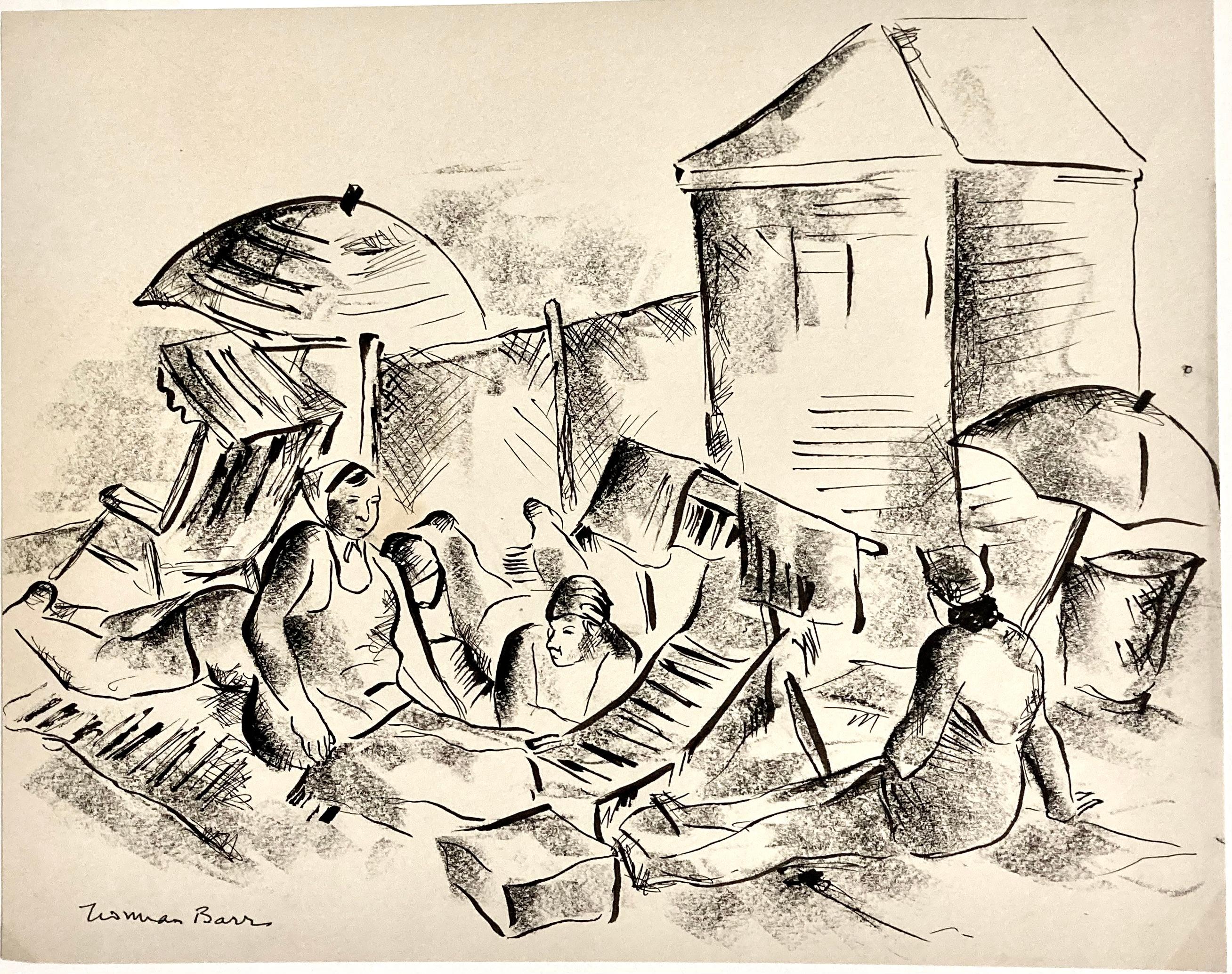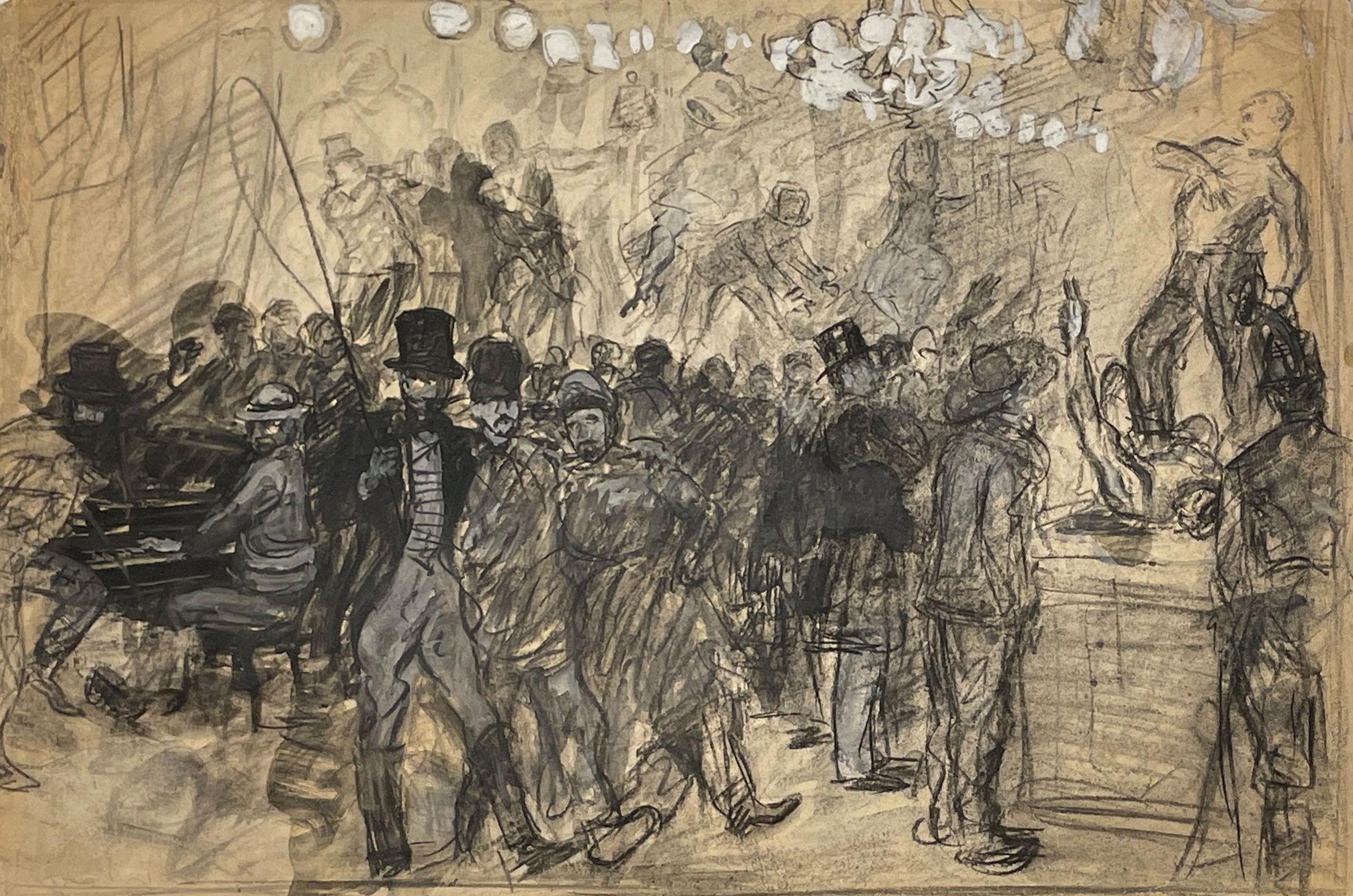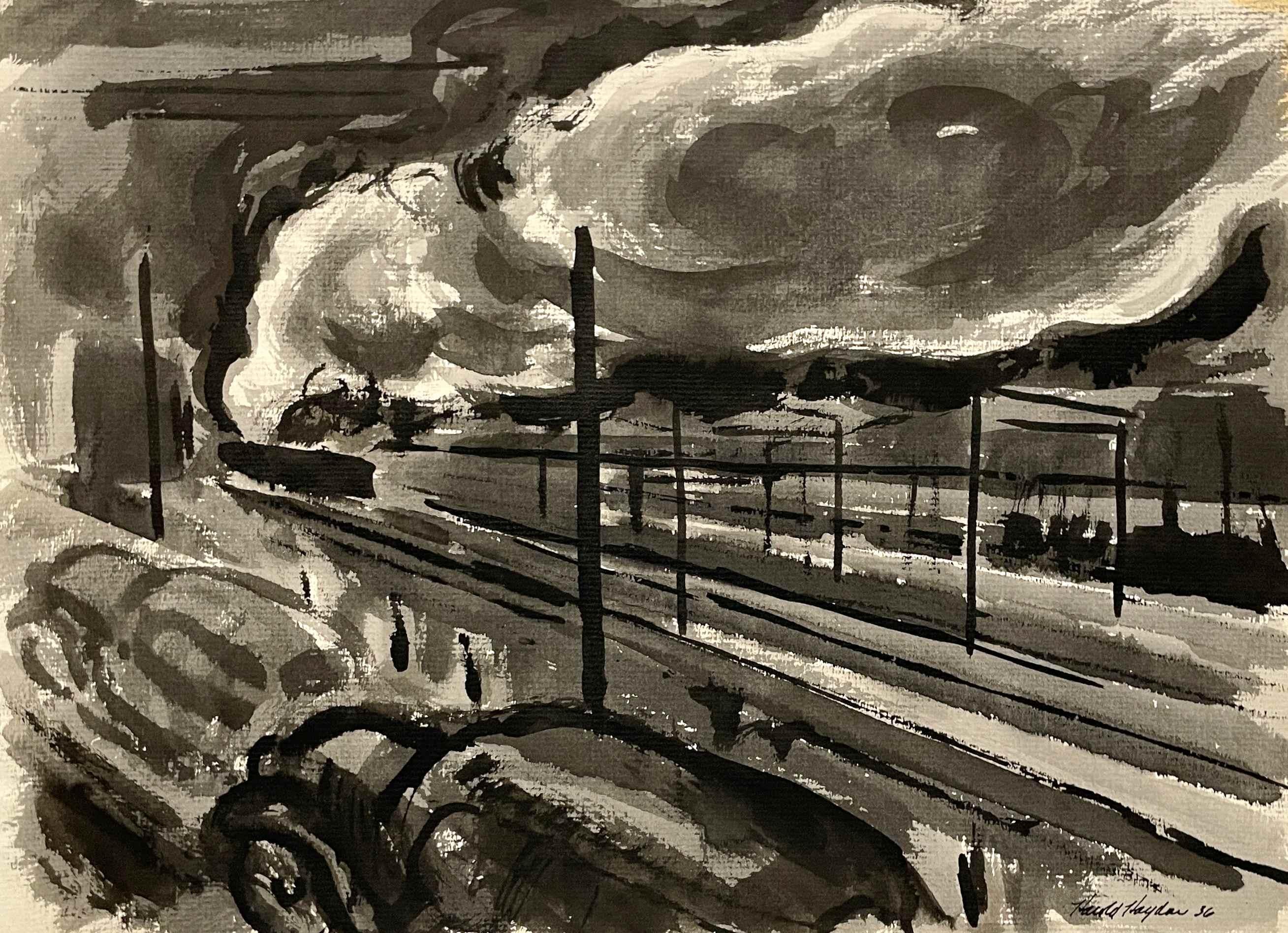Items Similar to "Building" George Luks, Cityscape, Ashcan School, Gothic Cathedral
Want more images or videos?
Request additional images or videos from the seller
1 of 5
George Luks"Building" George Luks, Cityscape, Ashcan School, Gothic Cathedral
About the Item
George Luks
Building
Signed lower right
Black crayon on paper
Sight 8 1/4 x 5 1/2 inches
Provenance:
M. Knoedler & Co., New York
Foster Brothers, Boston
Joan Peterson Gallery, Boston
Christie's New York, House Sale, September 8, 2005, Lot 107
George Luks was born on August 13, 1867 in Williamsport, Pennsylvania. Luks received his first art instruction from his parents who pursued painting as a hobby. At seventeen he entered the Pennsylvania Academy of Fine Arts. Later he went to Düsseldorf where he lived with a distant relative, a retired lion-tamer. He abandoned Düsseldorf for the more stimulating spheres of London and Paris. When he returned to America he worked as an artist for Philadelphia newspapers. In 1896 he was sent to Cuba as a war artist; rumor had it he was captured by the Spaniards and condemned to death as a spy, but he was deported instead and landed in New York, cold, hungry and broke.
In 1894 he joined the staff of the "Philadelphia Press" as an illustrator. He moved into a one-room flat with fellow illustrator, Everett Shinn. Through his illustration work, Luks became acquainted with William Glackens, John Sloan and eventually Robert Henri and these artists including Shinn later became known as the Philadelphia Five.
In April of 1896, after serving as a war correspondent in Cuba, Luks moved to New York City where he joined the staff of the "New York World" and began to draw a comic strip. He spent some time doing comic strips and then gave up newspaper work to devote his full energies to painting. His early experience as a newspaper artist had stimulated his interest in the American scene. Choosing the sidewalks of New York City as his province he proceeded to paint the subjects he saw there with a frankness that dismayed the academicians. He turned to landscape painting with enthusiasm.
Luks taught at the Art Students League from 1920 through 1924 and he later conducted his own classes in his own studio. Luk's personality was as famous as his paintings. A loud, boastful but purportedly good-humored man, he was also a heavy drinker. On October 29, 1933, he was found dead on the streets of New York City, a casualty of a barroom brawl.
- Creator:George Luks (1867 - 1933, American)
- Dimensions:Height: 18.5 in (46.99 cm)Width: 14.5 in (36.83 cm)
- Medium:
- Movement & Style:
- Period:
- Condition:
- Gallery Location:New York, NY
- Reference Number:1stDibs: LU1841213537692
About the Seller
5.0
Platinum Seller
These expertly vetted sellers are 1stDibs' most experienced sellers and are rated highest by our customers.
Established in 2021
1stDibs seller since 2022
60 sales on 1stDibs
Typical response time: 1 hour
- ShippingRetrieving quote...Ships From: New York, NY
- Return PolicyA return for this item may be initiated within 3 days of delivery.
More From This SellerView All
- "Street Fair” William Glackens, Ashcan School, Street Scene, Carnival, BoxingBy William GlackensLocated in New York, NYWilliam Glackens Street Fair, circa 1905 Pencil, ink and gouache on paper 10 x 14 inches Provenance: The artist Kraushaar Galleries, New York Estate ...Category
Early 1900s Ashcan School Landscape Drawings and Watercolors
MaterialsGouache, Pencil, Paper, Ink
- "Tokyo Diptych, " Yvonne Jacquette, Japanese Urban Cityscape Nocturnal AerialBy Yvonne JacquetteLocated in New York, NYYvonne Jacquette (American, b. 1935) Tokyo Diptych, 1985 Pastel on paper Overall 17 1/4 x 28 1/2 inches Signed lower center Provenance: Carey Ellis Company, Houston, Texas Brooke Alexander, New York Collection of an American Corporation Exhibited: New York, Brooke Alexander, Yvonne Jacquette: Tokyo Nightviews, April 5 - May 3, 1986, n.p., illustrated; this exhibition later traveled to Brunswick, Maine, Bowdoin College Museum of Art, Yvonne Jacquette: Tokyo Nightviews, June 27 - August 24, 1986. Yvonne Jacquette has a preference for high places, a circling plane, a penthouse window, an aerie from which to watch the world. Her work has often depicted the city and man-made landscape from the vantage of angels. It is a privileged perspective, long loved by photographers, who were perhaps the first to recognize the geometric grandeur of the city below. That grandeur structures Jacquette's images but is not its full content. Her work attempts to resolve the visual and emotional pardoxes of the modern metropolis. Only from the tower is there the possibility of order and context. And unlaced beauty. Jacquette first visited Japan in 1982. Nighttime Tokyo, its cars and crowds and canyons of loud Vegas neon, made a vivid and bewildering impression on her. The neon signs, pulsing, scaling the walls of high rises, fascinated the artist, "like Times Square spread over miles." Her fascination was equal parts marvel, confusion, and curiosity—the sparks of art. She returned to Tokyo in May of 1985, choosing hotel rooms with expansive vistas. From these views Jacquette excerpted images for a series of pastel night scenes. The basic forms and colors of each drawing were blocked in during night sessions by the window. She worked in the dark, selecting colors by flashlight. In daylight, she sharpened the geometry and corrected ambiguous passages. She refined the drawings further in the studio until the images read clearly. Photographic correctness was not important. The finished drawings are complete statements, not simply preparatory sketches for paintings. They have the authority of expert witness. In clear, discreet jots of pastel they record the performance of seeing, each touch of color attesting to a moment's close scrutiny. Yvonne Jacquette was born on December 15, 1934 in Pittsburgh, Pennsylvania and grew up in Stamford, Connecticut. She attended the Rhode Island School of Design, Providence from 1952 to 1955, when she moved to New York City. Her late husband was photographer Rudy Burckhardt, and the couple were part of a circle of artist friends that included Fairfield Porter, Alex Katz, Red Grooms, and Mimi Gross. She continues to live and work in New York City, as well as in Searsmont, Maine. A flight to San Diego in 1969 sparked Jacquette’s interest in aerial views, after which she began flying in commercial airliners to study cloud formations and weather patterns. She soon started sketching and painting the landscape as seen from above, beginning a process that has developed into a defining element of her art. Her first nocturnal painting...Category
1980s American Modern Landscape Drawings and Watercolors
MaterialsPaper, Pastel
- "New York City Harbor (Brooklyn Bridge), " Leon Dolice, East River, Mid-CenturyBy Leon DoliceLocated in New York, NYLeon Dolice (1892 - 1960) New York Harbor (Brooklyn Bridge), circa 1930-40 Pastel on paper 12 x 19 inches Signed lower right Provenance: Spanierman Gallery, New York The romantic b...Category
1930s American Modern Landscape Drawings and Watercolors
MaterialsPaper, Pastel
- "New York Yankees World Series Celebration, " Kamil Kubik Baseball Street ParadeBy Kamil KubikLocated in New York, NYKamil Kubik (1930 - 2011) The New York Yankees 1998 Baseball World Series Celebration, 1998 Pastel on paper Sight 26 x 19 1/2 inches Provenance: The artist's estate The 1998 New York Yankees were one of the best baseball teams ever, comprising players such as Jorge Posada, Tino Martinez, Chuck Knoblauch, Scott Brosius, Derek Jeter...Category
1990s Post-Impressionist Landscape Paintings
MaterialsPaper, Oil Pastel
- "New York City Harbor" Leon Dolice, Downtown Skyline, East and Hudson RiverBy Leon DoliceLocated in New York, NYLeon Dolice (1892 - 1960) New York Harbor Skyline at Twilight (Searching), circa 1930-40 Pastel on paper 12 x 19 inches Signed lower left Provenance: Spanierman Gallery, New York T...Category
1930s American Modern Landscape Drawings and Watercolors
MaterialsPaper, Pastel
- "Hydrangeas, " Walter Inglis Anderson, Mississippi Southern Illustrator, FlowersLocated in New York, NYWalter Anderson ( American, 1903 - 1965) Hydrangeas, circa 1950 Mixed media on paper 11 x 8 1/2 inches Provenance: Luise Ross Gallery, New York Private Collection, New Jersey Acquired from the estate of the above, 2021 Walter Anderson firmly believed that quality art was an important part of life and should be made available to everyone. As he said, "There should be simple, good decorations, to be sold at prices to rival the five-and-ten." Noticing that only poor quality art was available in stores and little was available for children, he resolved to make art which could be reproduced easily and sell inexpensively — linoleum block prints. This technique enabled him to provide affordable, quality art. The technique of linoleum block printing is a simple concept; however, it requires much skill and talent to actually produce memorable art. Anderson purchased surplus "battleship linoleum," thicker than ordinary linoleum with a burlap backing for better support, to create his blocks. During the mid-1940s, he created almost 300 linocuts working in the attic of the sea-side plantation house, Oldfields, his wife's family home in Gautier. Masses of linoleum chips accumulated at the foot of the attic stairs as he often worked night and day. He began with sketching out a design directly on the linoleum. Once he had carved the image into the surface, he used the back of faded, surplus stock wallpaper that a friend sent him, laying long strips on top of the inked linoleum. A roller made of sewer pipe filled with sand served as his press. When the print was completed, he often colored it by hand with bold strokes and vivid colors. The prints were sold at Shearwater Pottery, the family business, for a mere dollar a foot. But "what about a well-designed fairy tale for a child's room?" he asked himself. Since there was a lack of affordable art for children, much of his work with linoleum blocks focused on subjects for children. He depicted fables and fairy tales ranging from Arabian Nights, to Germany and the Grimm Brothers' Rapunzel, to the French story of The White Cat, to the Greek tales such as Europa and the Bull, and to tales from China, India, and other cultures. Anderson also created "mini" books featuring the alphabet and Robinson Cat. The blocks are not only alive with the story being depicted, but they are also filled with designs taken from Best-Maugard's Method for Creative Design. Swirls, half-circles and zig-zag lines fill every available space on the linoleum block making them come alive and capture their audience. But fairy tales, children's verses and the "mini" books, consisting of about 90 blocks, were not the sole subject of Anderson's linoleum block prints. In total, he created approximately 300 linoleum blocks with subjects ranging from coastal flora and fauna, coastal animals, and sports and other coastal activities. Anderson even created linoleum blocks to be used to print tablecloths and clothing, some worn by his own children. Color and subjects of the linoleum block prints were not the only things that got them noticed. In 1945 when Anderson was creating these prints, the standard size of linoleum block prints was only 12 by 18 inches. These small dimensions were due to the common size of the paper available and the restrictions made by national competitions. Since Anderson used wallpaper...Category
Mid-20th Century American Modern Landscape Paintings
MaterialsPaper, Crayon
You May Also Like
- Norman Barr, Delancey Street (NYC)By Norman BarrLocated in New York, NYNorman Barr recorded his beloved New York City from the Bronx, to Coney Island, to the Fulton Fish Market. In this period he was on the New Deal's Mural ...Category
Mid-20th Century Ashcan School Figurative Drawings and Watercolors
MaterialsIndia Ink, Crayon
- Norman Barr, Coney Island (large), 1940By Norman BarrLocated in New York, NYNorman Barr recorded his beloved New York City from the Bronx, to Coney Island, to the Fulton Fish Market. In this period he was on the New Deal's Mural ...Category
Mid-20th Century Ashcan School Figurative Drawings and Watercolors
MaterialsCrayon, India Ink
- Untitled (Rail Yard)By Harold HaydonLocated in Chicago, ILA 1936 ink on paper drawing of a rail yard by artist Harold Haydon. Harold Emerson Haydon was born in Fort William, Ontario, Canada in 1909. Haydon came to Chicago with his family...Category
1930s Ashcan School Landscape Drawings and Watercolors
MaterialsInk, Paper
- Mal's (At Cliff Evan's Cabin)Located in Salt Lake City, UTMal's (At Cliff Evan's Cabin), by Waldo Midgley. watercolor, 9 x 12 inches (Framed size: 18.5 x 21 inches), $1,500 Waldo Midgley (1888-1986) had a fruit...Category
Mid-20th Century Ashcan School Landscape Drawings and Watercolors
MaterialsWatercolor
- Bridge to Brooklyn #382Located in Salt Lake City, UTBridge to Brooklyn #382, watercolor, 10.5 x 14 inches (Framed size: 18 x 21 inches), $1,750 Waldo Midgley (1888-1986) had a fruitful career spanning eig...Category
1970s Ashcan School Landscape Drawings and Watercolors
MaterialsWatercolor
- Paul Gattuso, (Italian Street Scene - Light)By Paul Gattuso.Located in New York, NYPaul Gattuso attended the Art Students League and worked primarily in New York City. There is an old address with a Bronx, Grand Concourse address. Gattus...Category
1930s Ashcan School Figurative Drawings and Watercolors
MaterialsMonotype
Recently Viewed
View AllMore Ways To Browse
Carlos Catasse
Elliott Erwitt Dog
Harry Potter Chamber Of Secrets
Italian Ceramic Snow Leopard
Jean Baron Tapestry
Karel Appel Silkscreen On Foil
Kiro Urdin
Lodewijk Bruckman
Peau De Peche
Babies First Step 2002
Blue Dog Cajun Man
Carolyn Meyer
Ckl Samarasinha
Donald Sultan Buttons
Jef Bourgeau
John Findysz
Large Antique English Oil Painting Barn
Large Outdoor Sculptures Near Me




